Excerpts from Jim Conrad's
Naturalist Newsletter

from the August 24, 2014 Newsletter issued from the Frio Canyon Nature Education Center in the valley of the Dry Frio River in northern Uvalde County, southwestern Texas, on the southern border of the Edwards Plateau; elevation ~1750m (~5750 ft); N29.62°, W99.86°; USA
GOLDEN PRAIRIE-CLOVER
During these hottest, driest dog-days of a very droughty summer most of our wildflowers look pretty scrappy, their meager leaves curled and stiff with dryness, and if they're flowering at all, the blossoms generally are small and inconspicuous. That's certainly the case with one knee-high plant that was so austere and dusty looking I could hardly make out its stiff stems topped with modest, egg-shaped flowering heads amidst a general clutter of parched roadside grasses, as seen below:
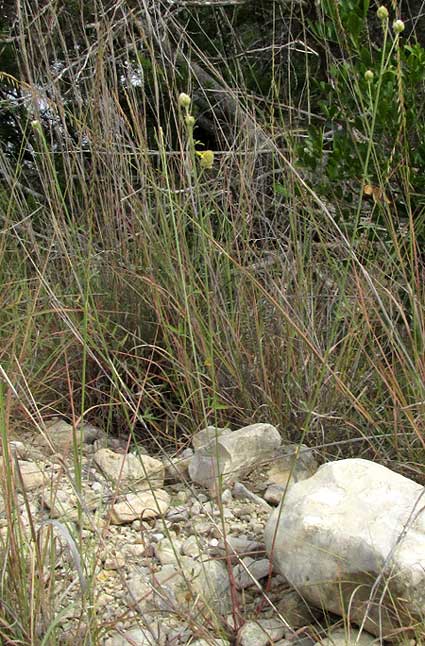
Up close, however, the grape-size flowering heads revealed themselves as hubs of activity, with attractions worth paying attention to, as you can see at the top of this page.
On the flowering head's left side notice the green caterpillar of the Reakirt's Blue butterfly, Echinargus isola, a common species here that feeds on many members of the Bean Family. Another indication that our plant belongs to the Bean Family is that the flower head's general appearance is very similar to that of a head of clover, and clovers are Bean Family members. Also, the yellow blossom is strongly bilaterally symmetrical, with a definite upper petal, two side petals, and two petals below fused along their common side into a scoop-like shape, exactly as with the Bean Family's "papilionaceous" blossoms. A view of the blossom in the head seen from the front is shown below:
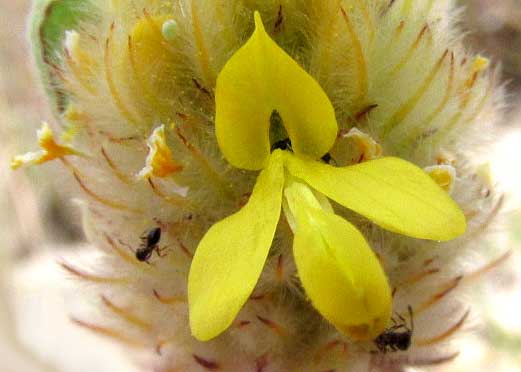
More robust plants develop taller flowering heads, as shown below:
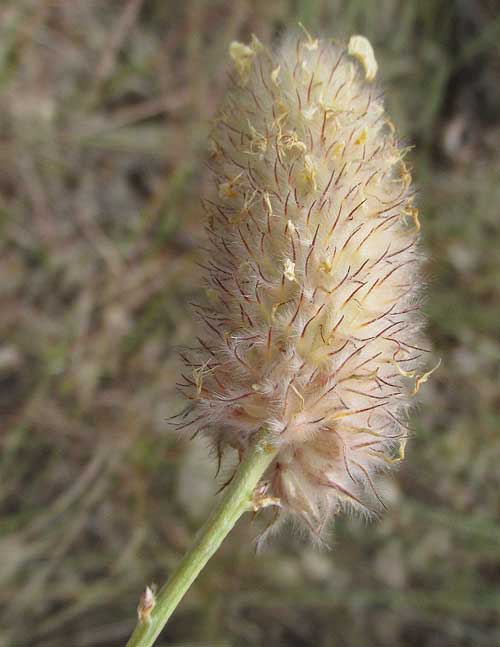
The fuzzy heads disintegrate into individual hairy calyxes inside which there's a roundish, wafer-like legume normally with a single seed, or bean, as shown below:
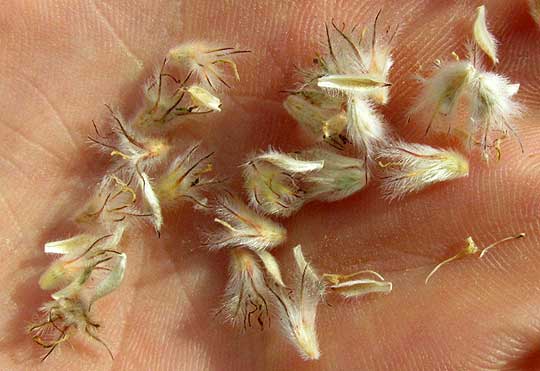
It's a bit unusual for legumes to remain inside their calyxes when they fall. I suppose the advantage in this case is that wind catches in the calyx's fuzz, helping the legumes travel into new territory.
The plant's pinnately compound leaves with their five leaflets also are typical of the Bean Family, as seen below:
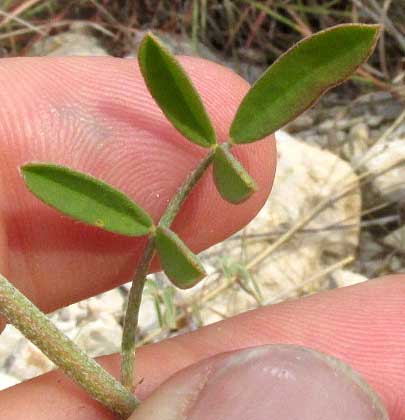
Pictures on the Internet show more robust plants with more numerous flowers in their heads so probably our plants are somewhat stunted by the drought.
Though the yellow flowers display normal Bean-Family papilionaceous structure, they're still a bit peculiar looking because of how their two lower, fused petals -- the "keel" in papilionaceous terms -- are so slender and so stiffly project well beyond the other petals. Also, it's noteworthy how the two side, or "wing," petals, jut outward with their sides held horizontally.
This May we encountered all these traits in a different wildflower, except that the May one was very much smaller than the current knee-high one. The May wildflower was the Dwarf Prairie-clover, Dalea rubescens, with whom you can compare our present find at http://www.backyardnature.net/n/h/dalea.htm.
So, our knee-high plant must be another species of Dalea -- and notice that the name is not Dahlia, which is a garden favorite and member of the Composite or Daisy Family. Members of the genus Dalea are often known as prairie clovers or indigo bushes -- though the Indigo plant is not closely related. About 67 Dalea species are listed for North America, with several possibly turning up here. However, most species produce blue/violet/purple flowers, so that helps with identifying our knee-high, yellow-flowered species.
Here we have DALEA AUREA, known variously as the Golden Prairie-clover, Golden Dalea, and Silktop Dalea. It commonly occurs throughout the US prairie states from South Dakota, through here into much of northern Mexico.
Livestock find Golden Prairie-clover to their liking, which may explain why I haven't seen it except on a roadside through a ranch without livestock.
Native Americans used Golden Prairie-clover to treat diarrhea and colic.